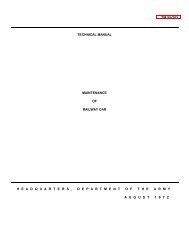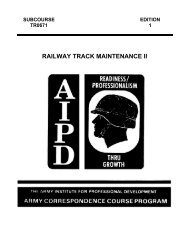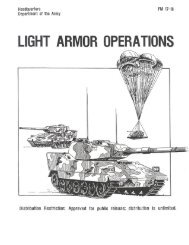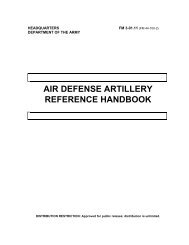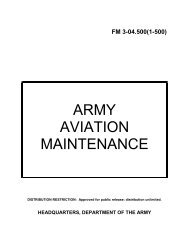fm 44-100 us army air and missile defense operations
fm 44-100 us army air and missile defense operations
fm 44-100 us army air and missile defense operations
You also want an ePaper? Increase the reach of your titles
YUMPU automatically turns print PDFs into web optimized ePapers that Google loves.
FM <strong>44</strong>-<strong>100</strong><br />
AIR DEFENSE ESTIMATE NUMBER____<br />
3. Strength. Numbers <strong>and</strong> sizes of committed <strong>and</strong> reinforcing units. Consider the location of the threat, threat<br />
doctrine, <strong>and</strong> the unit's mission. Identify <strong>air</strong> <strong>and</strong> <strong>missile</strong> assets <strong>and</strong> <strong>air</strong> support units that could or may affect the<br />
operation. When, where, <strong>and</strong> how many <strong>air</strong> platforms will the threat fly during this operation?<br />
B-4<br />
4. Other considerations. Threat forces not disc<strong>us</strong>sed above.<br />
5. Recent <strong>and</strong> present significant activities. Summary of recent threat activities that were both successful<br />
<strong>and</strong> unsuccessful. Highlight any threat <strong>air</strong> activity to include number, type of <strong>air</strong> platforms, <strong>and</strong> locations.<br />
6. Peculiarities <strong>and</strong> weaknesses. Indicate threat peculiarities <strong>and</strong> weaknesses that might influence combat<br />
effectiveness, including vulnerability to deception.<br />
7. Threat Courses of Action. A compilation of available information from which to draw concl<strong>us</strong>ions about<br />
possible threat <strong>air</strong> courses of action <strong>and</strong> how they relate to the threat ground courses of action.<br />
(c) Friendly forces. The friendly force <strong>air</strong> <strong>and</strong> <strong>missile</strong> <strong>defense</strong> forces disposition, composition, <strong>and</strong> strength.<br />
Highlight the vulnerability of the force to threat <strong>air</strong> <strong>and</strong> <strong>missile</strong> attacks <strong>and</strong> surveillance.<br />
1. Friendly courses of action. State the force comm<strong>and</strong>er's course of action. Include any guidance that<br />
affects <strong>air</strong> <strong>and</strong> <strong>missile</strong> <strong>defense</strong> <strong>operations</strong>. Include description of any phasing of <strong>operations</strong> in the courses of action<br />
<strong>and</strong> the impact of those <strong>operations</strong> on support relationships or requirements.<br />
2. Current stat<strong>us</strong> of resources within staff area of responsibility. The stat<strong>us</strong> of personnel <strong>and</strong> logistics in<br />
the unit. Identify civil-military <strong>operations</strong> requirements. Identify limitations that affect or may affect the conduct of <strong>air</strong><br />
<strong>and</strong> <strong>missile</strong> <strong>defense</strong> <strong>operations</strong>. Can the mission be accomplished?<br />
3. Current stat<strong>us</strong> of other resources that affect ADA area of responsibility.<br />
4. Comparison of requirements vers<strong>us</strong> capabilities <strong>and</strong> recommended solutions.<br />
5. Key considerations (evaluation criteria) for COA supportability.<br />
(d) Assumptions.<br />
3. ANALYSIS<br />
Analyze each COA <strong>us</strong>ing evaluation criteria to determine advantages <strong>and</strong> disadvantages. Identify those aspects in the<br />
comm<strong>and</strong>er's plan which create difficulty in providing <strong>air</strong> <strong>and</strong> <strong>missile</strong> <strong>defense</strong> coverage <strong>and</strong> affect the ability of the force<br />
to accomplish its mission.<br />
4. COMPARISON<br />
Compare COAs <strong>us</strong>ing evaluation criteria. Rank order COAs for each key consideration. A decision matrix should<br />
visually support comparison. Present an <strong>air</strong> <strong>defense</strong> course of action for each of the supported force courses of action.<br />
Each ADA course of action presented should include the following aspects:<br />
• Air <strong>defense</strong> mission.<br />
• Air <strong>defense</strong> priorities.<br />
• Air <strong>defense</strong> fires.<br />
• Air <strong>defense</strong> scheme of maneuver.<br />
• ADA task organization.<br />
• Comm<strong>and</strong> <strong>and</strong> support relationships.<br />
Figure B-1. AD Estimate General Format (continued)




